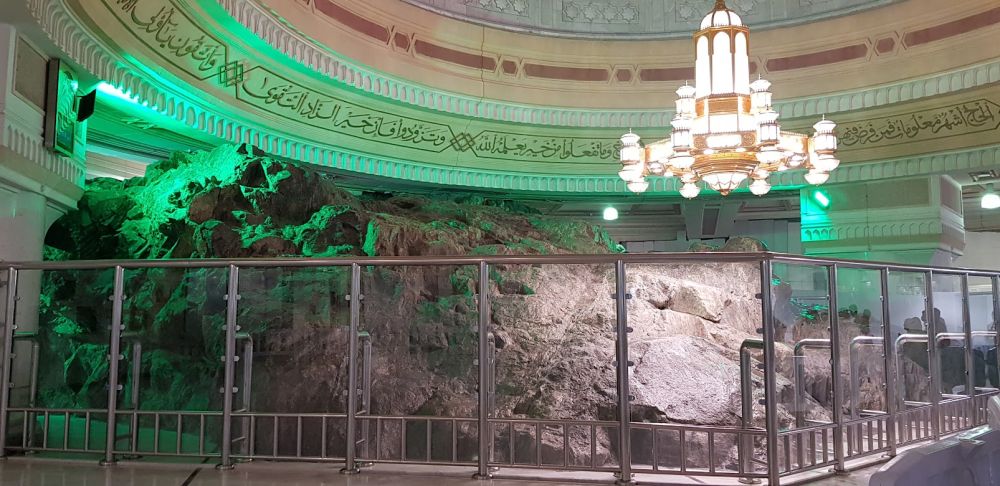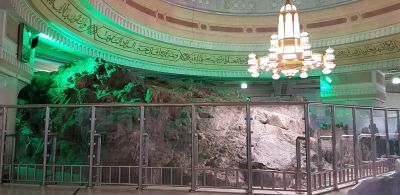

Sa’i is a fundamental ritual of the Islamic pilgrimage, both during Hajj and Umrah. It involves walking back and forth seven times between the hillocks of Safa and Marwa, which are now enclosed within the Masjid al-Haram complex. This ritual commemorates the actions of Hagar, the wife of Prophet Abraham, who ran between these hills in desperate search for water for her son Isma'il. As part of this ritual, pilgrims reflect on the patience, perseverance, and unwavering faith of Hagar. This activity can be deeply spiritual and provides an opportunity for introspection and prayer. The pathway is now fully air-conditioned and paved, making it accessible to all pilgrims, including those with physical disabilities. Special lanes are designated for the elderly and those in wheelchairs.
Near Safa and Marwa is the sacred Zamzam well, believed to have been miraculously provided by Allah for Hagar and her son Isma'il. Drinking Zamzam water is an important part of completing the rituals of Umrah and Hajj. Pilgrims drink from the many fountains and coolers that distribute this blessed water throughout the Grand Mosque. It is an age-old tradition that stretches back thousands of years, and to this day, the water from the Zamzam well is considered holy and has significance in the hearts of Muslims, who often collect it to take home. The Zamzam well area has an intriguing history, and although directly accessing the well is not possible, the experience of drinking the water is spiritually gratifying.
Adjacent to Sa'i area, Masjid al-Haram is the largest mosque in the world and surrounds the Kaaba, the holiest site in Islam. Praying at Masjid al-Haram is a deeply spiritual experience for Muslims, as it is the focal point of the Islamic faith. Pilgrims come from all around the world to perform prayers in this sacred mosque. The experience is amplified by the sense of unity and peace that comes with praying alongside millions of other believers. The mosque is an architectural marvel, with its expansive Ottoman and Abbasid-style pavilions, intricately decorated with Islamic art and calligraphy. Visitors can participate in the five daily prayers, listen to sermons, or engage in individual acts of worship. The mosque also offers an opportunity to pray at the Station of Ibrahim and other significant areas.
The expansion area of the Grand Mosque is a testament to modern Islamic architecture and accommodates the ever-increasing number of pilgrims. Visitors can explore the area, which encompasses newer sections of the mosque, feature intricate designs, modern facilities, and vast, open prayer spaces. The areas around Safa and Marwa also form part of this expansion and are integrated seamlessly into the overall structure. The skillful blend of tradition and contemporary design in this expansion aims to preserve the essence of the historical site while offering improved functionality. It's an excellent place for those interested in architectural design and the logistical challenges of hosting millions of pilgrims annually.
Although Tawaf is not directly performed at Safa and Marwa, witnessing the circumambulation of the Kaaba, known as Tawaf, is an integral part of the pilgrimage rituals. Tawaf entails circling the Kaaba seven times in a counterclockwise direction, with each circuit known as a 'Shawt'. Pilgrims perform this act while reciting prayers and supplications. Observing Tawaf offers a deeper understanding of the Islamic faith and the conviction of the pilgrims as they perform this devotional act. Visitors can experience the intense spirituality and collective devotion of the Muslim faithful. It's an awe-inspiring sight, rich in symbolism, and provides a deeper understanding of the oneness of the Muslim community.
For those interested in the rich history of Makkah and Islamic history, the Library of Makkah—located near the Grand Mosque—offers a wealth of information. It houses ancient manuscripts, Islamic texts, and artifacts that document the history of Makkah and the Islamic world. The exhibition provides insights into the Islamic heritage and offers educational tours that are informative and enriching. Besides valuable texts, the library frequently features exhibits on various aspects of Islamic culture and history, which can help visitors understand the significance of Safa, Marwa, and the surrounding areas in context.
The Maqam-e-Ibrahim, also known as the Station of Abraham, is a rock that holds the imprints of Abraham's feet and is encased in glass near the Kaaba. This site holds immense historical and religious significance for Muslims, marking the place where Abraham stood while constructing the Kaaba. Its proximity to Safa and Marwa allows pilgrims to visit the station and offer two units of prayer, as recommended after performing Tawaf. Observing this relic up close encourages reflection on the foundations of the Islamic faith and provides an additional layer of spiritual depth to the pilgrimage experience.
Several educational programs and workshops are held within the vicinity of the Grand Mosque, which can include topics such as the rituals of Hajj and Umrah, Islamic history, and the significance of Safa and Marwa. These programs are aimed at enriching the knowledge of pilgrims and visitors, providing them with a deeper spiritual and intellectual connection to the acts of worship they perform. Sessions are often conducted by knowledgeable scholars and can include Q&A sessions, allowing for an interactive and engaging learning experience.
Located not far from the Grand Mosque complex, the Clock Tower Mall is part of the Abraj Al Bait complex. It offers a wide range of shopping, dining, and entertainment options for visitors. After completing the spiritual rituals at Safa and Marwa, visitors can take time to explore the mall, which features a blend of international and local brands, exquisite Islamic artwork, and souvenirs. It's a modern commercial center that caters to the needs of pilgrims and tourists alike, providing a different pace and atmosphere from the spiritual activities within the mosque complex.
After the sun sets, the Grand Mosque takes on a different ambiance. The crowds thin out somewhat, and the cooler temperature along with the illuminated Kaaba and minarets create a serene environment. Pilgrims often find this time more conducive for reflection, prayer, and absorbing the tranquility of the sacred site. Many visitors make it a point to spend a part of their evening or night in contemplation, taking in the grandeur of the mosque and its environs, including Safa and Marwa, under the night sky. It is a powerful moment to internalize the experiences of the day and the significance of the pilgrimage.
